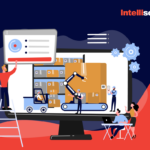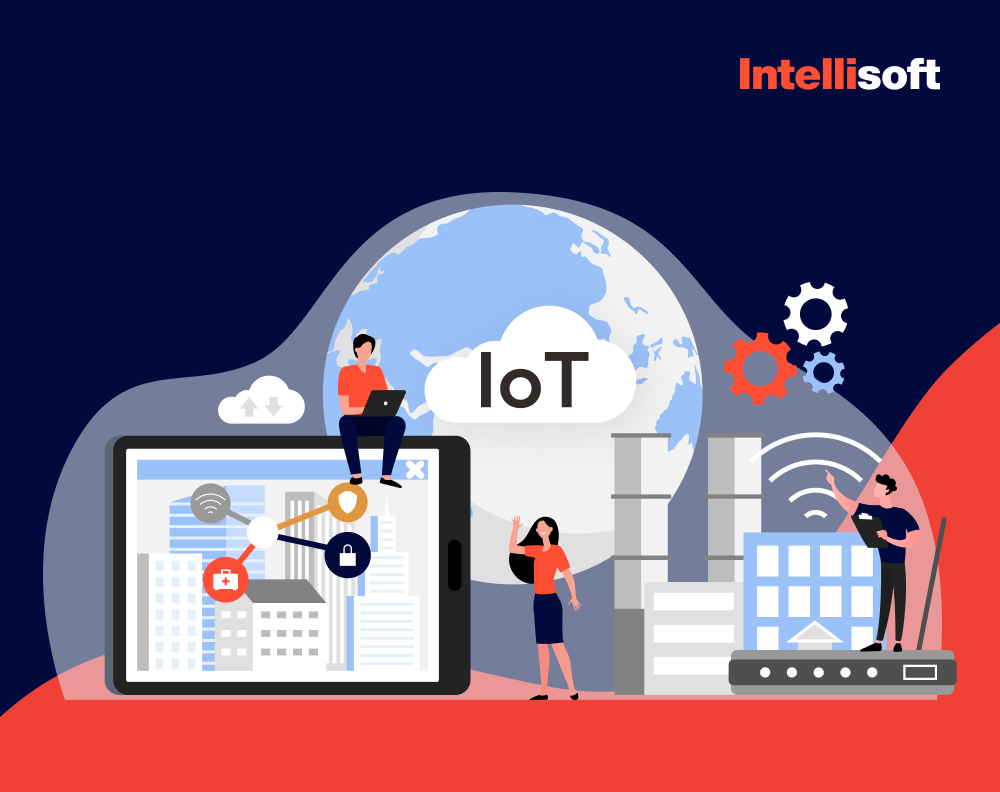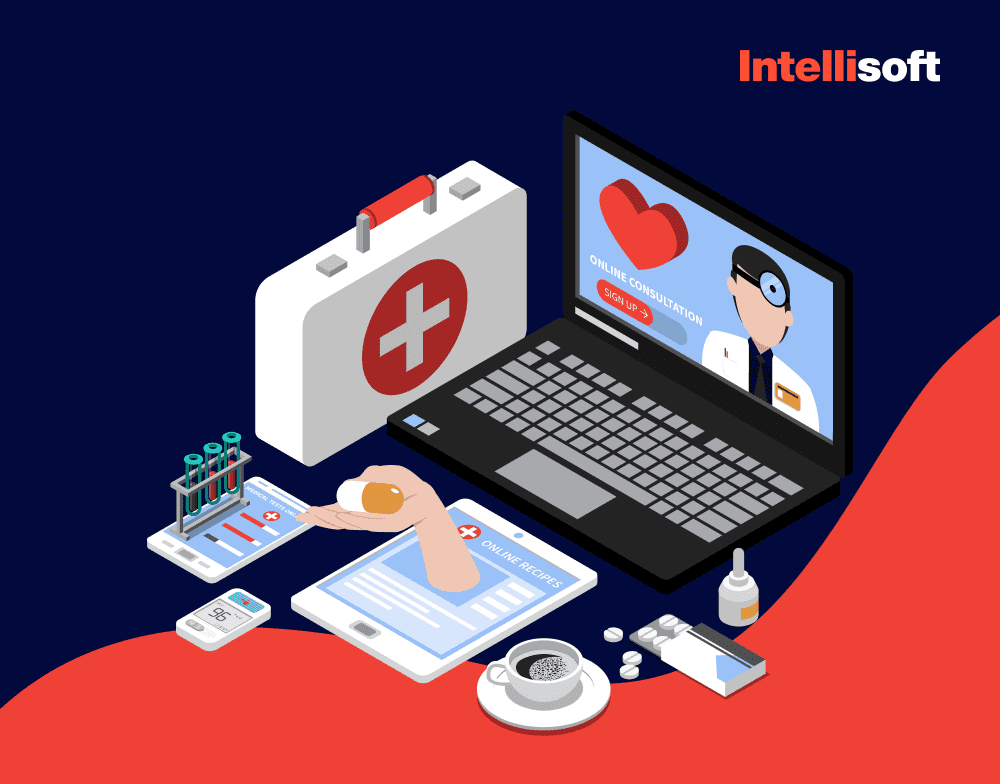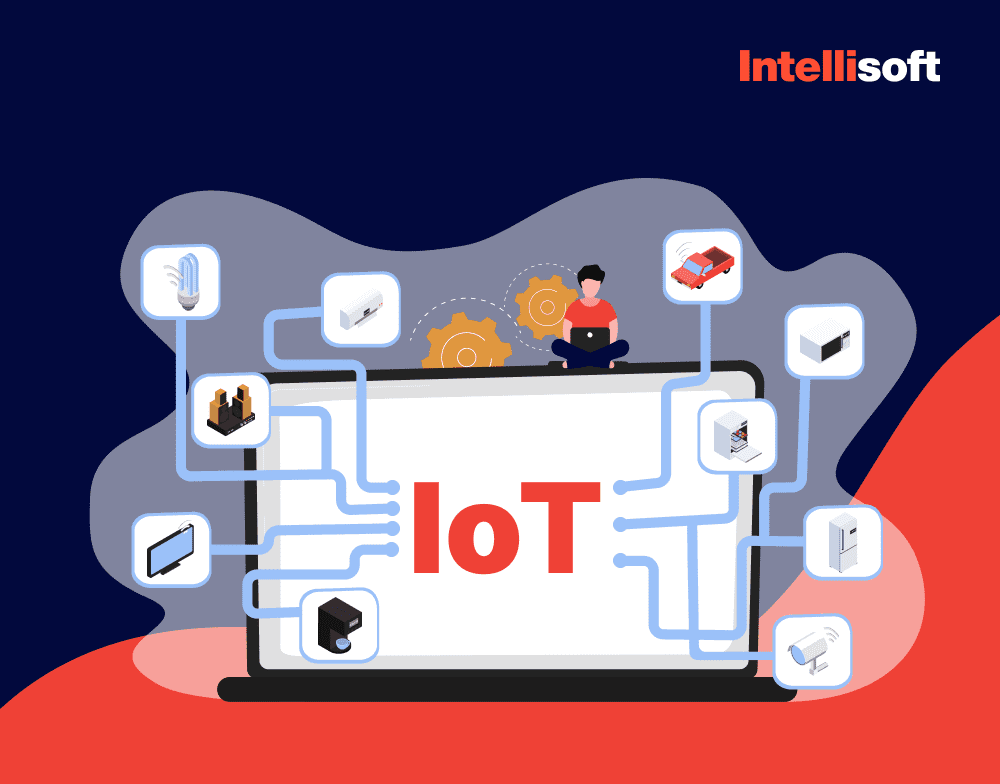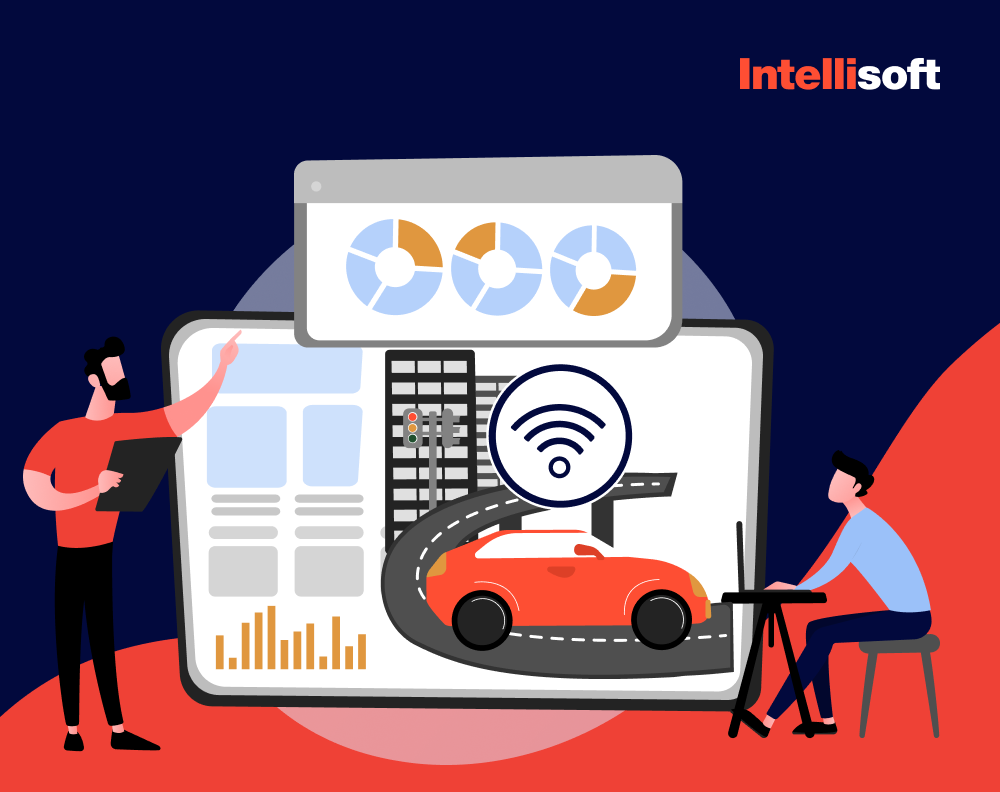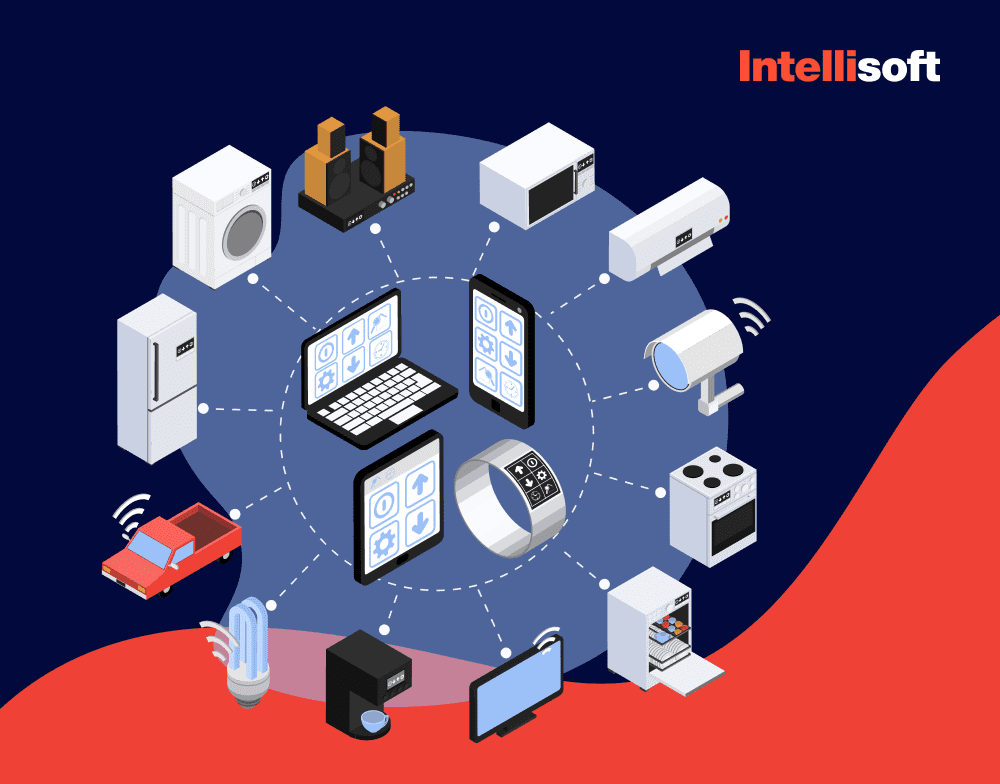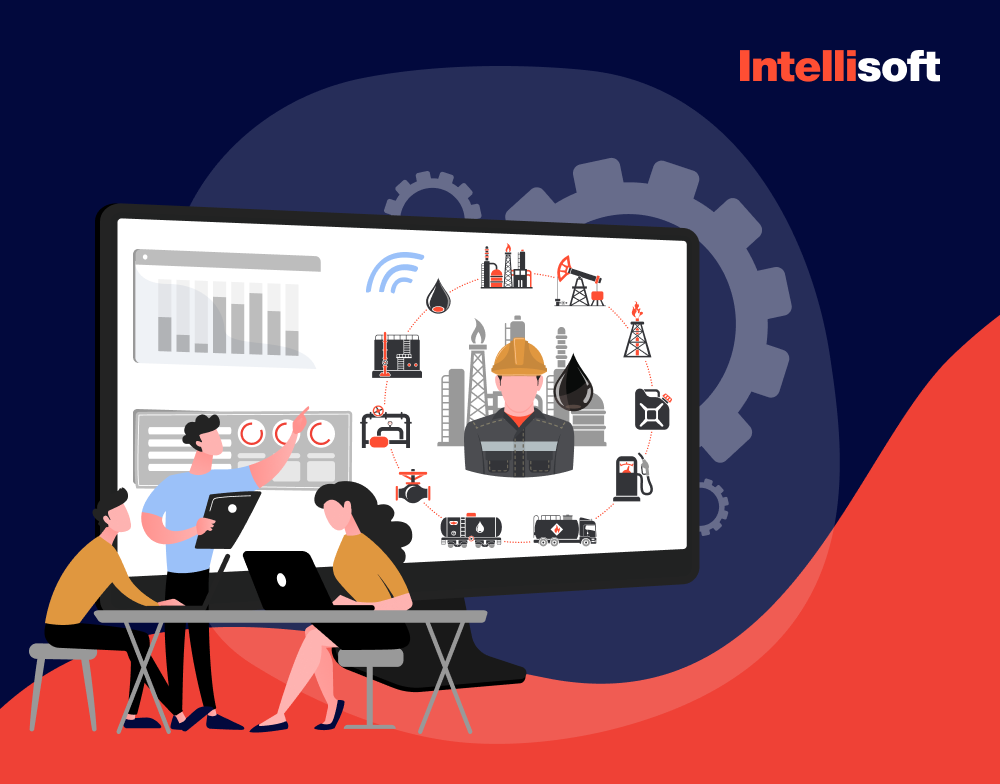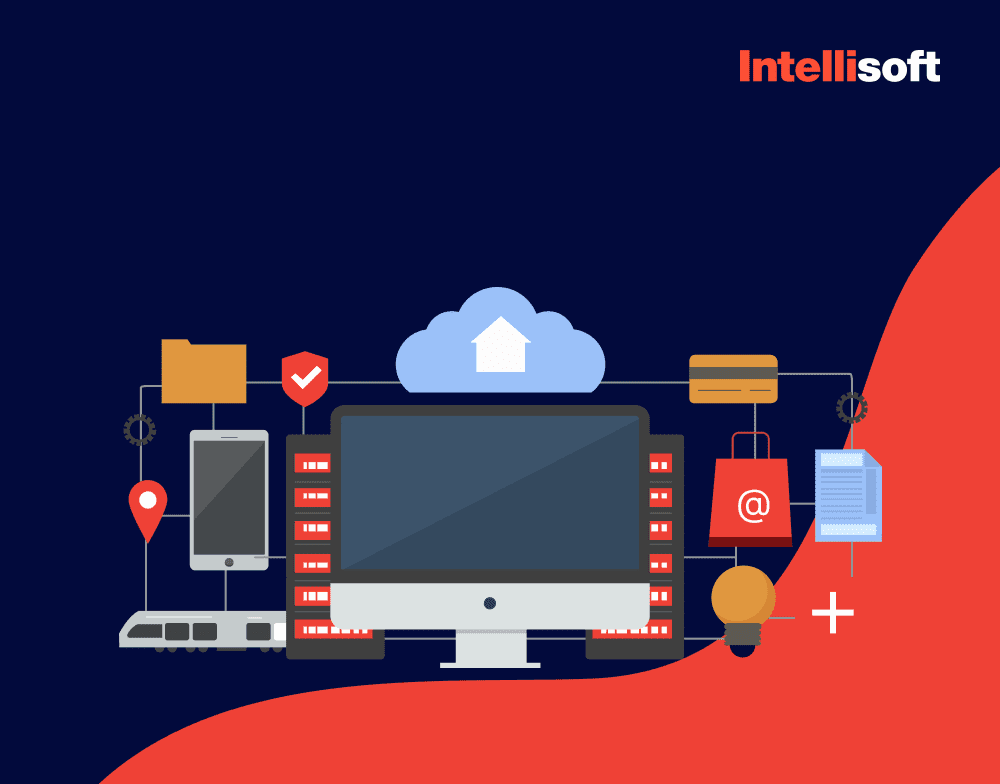The Internet of Things (IoT) is a new level of technology development. Thanks to up-to-date analytics, it’s possible to significantly increase the degree of utilization of various pooled devices, which has a significant economic effect (e.g., more accurate healthcare data for medical devices, ultimate transparency for logistics, etc.).
By 2025, there will likely be 30.9 billion IoT gadgets, according to a Statista analysis. This produces an enormous amount of data that firms must manage. Data generated by an IoT ecosystem needs to be organized and presented so that users can see trends and obtain insights. One of the best methods to deal with this difficulty is by developing an IoT dashboard.
You can come up with an IoT dashboard on your own or turn to experts. IntelliSoft provides IoT development services to help create customizable and interactive dashboards for better decision making, having worked with several business verticals and building innovative IoT applications. One of our clients, a well-known Swiss manufacturer of industrial heating systems, for instance, asked us to help with IoT solutions, including dashboards. IntelliSoft has a team of experts who can assist you in creating an IoT dashboard specifically for your needs (such as an IoT fleet management dashboard that will satisfy even the most demanding technical specifications).
So, how to сreate web dashboards for IoT devices? How can you build one? Find the answers below. But first of all, what is IoT application development?
IoT application development refers to the process of creating software solutions that harness the capabilities of the Internet of Things (IoT). IoT encompasses a vast network of interconnected devices, machines, and sensors that collect and transmit data to the cloud for analysis and action.
Table of Contents
What is IoT Dashboard?
An IoT (Internet of Things) Dashboard is a data visualization tool that plays a pivotal role in the IoT connections and ecosystem. It transforms, organizes, and presents data collected from network-connected devices in a visually accessible format. The primary purpose of an Internet of Things dashboard is to showcase real-time and historical insights into IoT data for easy monitoring and decision-making.
These dashboards typically include various elements such as numbers, graphs, and charts to represent data understandably. The specific data displayed on an Internet of Things dashboard can vary depending on the IoT solution, but it commonly covers information related to IoT devices and their performance.
Why Build IoT Dashboards?
Building Internet of Things dashboards serves several crucial purposes:
- Data Enhancement: IoT dashboards automatically enhance incoming data with additional contextual information, such as location, time, weather, temperature, and other external factors unique to your customers. This enriched data provides valuable insights and facilitates informed decision-making in various industries.
- Data Summarization: Custom IoT dashboards can summarize vast amounts of data in easily comprehensible graphs, charts, diagrams, and other visual formats. This summarization simplifies complex data sets, making it easier for users to understand and act upon the information.
- Data Sharing: IoT dashboards enable the sharing of important IoT data with partners and stakeholders. This collaborative feature enhances communication and cooperation, allowing multiple parties to access and benefit from real-time information.
- Remote Access: IoT dashboards hosted in the cloud can be accessed from anywhere with an internet connection. This accessibility is crucial for monitoring IoT devices and systems remotely, enabling users to stay connected and responsive even when not physically present.
- Enhanced Decision-Making: By providing a clear and concise view of IoT data, these dashboards empower businesses and individuals to make data-driven decisions, optimize operations, improve efficiency, and enhance overall performance.
What Type of Connections are Used for IoT?
IoT (Internet of Things) devices use various types of connections and IoT protocols to exchange data and communicate with other devices and systems. These connections include:
- Direct Internet Connection: IoT devices can connect directly to the internet via Ethernet, Wi-Fi, or cellular networks (e.g., 4G, 5G). This type of IoT device management protocols allows devices to send and receive data independently, making it suitable for remote and mobile applications.
- Mesh Networking: IoT devices can form mesh networks, where each device serves as a node that can relay data to other devices in the network. This type of IoT protocols improves network resilience and range, making it suitable for large-scale deployments and environments with potential connectivity challenges.
- Bluetooth: Bluetooth enables short-range wireless connections between IoT devices and nearby smartphones, tablets, or other devices. This type of IoT device management protocols is commonly used in applications like wearable devices and smart home gadgets.
- Zigbee and Z-Wave: These are wireless communication protocols designed for low-power, short-range communication between IoT devices. They are often used in smart home automation for devices like smart thermostats and door locks.
- LoRaWAN: LoRaWAN (Low Power Wide Area Network) is a long-range, low-power wireless communication technology ideal for IoT devices that need to transmit data over extended distances with minimal power consumption. It’s often used for applications like smart agriculture and asset tracking.
- Narrowband IoT (NB-IoT): NB-IoT is a cellular technology optimized for low-power, low-data-rate IoT applications. It provides a cost-effective way to connect a wide range of IoT devices to existing cellular networks.
- MQTT and CoAP: These are lightweight messaging protocols used for machine-to-machine communication in IoT. They are designed for efficient data transfer and are commonly used in IoT applications for publishing and subscribing to data.
How Can an IoT Dashboard Help You?
So, why is it a good idea to build IoT dashboards? To begin with, IoT may be accessed from anywhere as long as you have an Internet connection because it is hosted in the cloud. For instance, you can access online dashboards for IoT devices using a URL. Any firm can afford to move their data to the cloud and actually save money thanks to the accessibility and availability of cloud vendors like AWS and Google Cloud on a worldwide scale.
Second, when we consider the Internet, we just take into account the digital paradigm and don’t picture any physical objects. IoT incorporates the physical world into the digital one. We transport data from the actual world to our computers using IoT dashboards, which depict data as graphs, maps, charts, and widgets. In other words, it’s a method for converting data into visual graphics and using it to forward a specific objective.
Finally, everyone now can obtain access to IoT analytics, including CEOs, managers, staff members, and even customers. IoT dashboards are supported by any smart device and can be useful for both consumers and businesses due to their original function and design.
IoT Data Visualization
IoT data visualization is a technique that transforms raw data from many information streams into a more meaningful one. In order to make better business decisions, it analyzes the data and looks for specific patterns and behaviors. It aids in developing a workable company plan.
The most common form of IoT visualization is an IoT analytics dashboard. Simply put, an IoT dashboard is a functional platform that includes a backend and storage that can process data as well as an interface that displays data in a clear and simple manner. Enterprises can build their strategy and vision based on the visualized data.
IoT Data Visualization Benefits
IoT data visualization has a number of advantages:
- Revealed business opportunities
A web dashboard for IoT devices allows you to compare real-time data with information stored from a previous period to identify new opportunities for growth and development. - Enhanced business operations
IoT data supplements other business data. You can significantly improve your business operations by combining data from various sources. - Simple data sharing
Data visualization makes it easier and faster to share information with new people and businesses. - Improved control over IoT device performance
Any malfunctions or drops in performance will be immediately visible on an IoT monitoring dashboard. - Real-time decision making
Managers can make faster and more informed decisions when they have access to an insightful IoT dashboard with comprehensive multi-layered data. - Simplified data analysis
Laconic visual data is better understood by the human brain than massive information assets. As a result, IoT dashboards make daily data processing easier to manage. - Instantaneous choices
Managers can make decisions more quickly and with greater knowledge if they have access to an informative IoT dashboard with complete multi-layered data.

IoT Visualization Challenges
However, there are certain difficulties with IoT visualization. The most significant ones are listed below.
- Information generalization. This can obscure some findings since data abnormalities sometimes hide under an overall favorable impression.
- Human factor. People examining the displayed data may read it with a variety of emphasis points. Since data cannot explain itself, some users gain objective knowledge while others develop alternate interpretations by concentrating on different factors.
- Tool restrictions. All visualization tools have infrastructure, functionality, and scalability restrictions. Data evaluation and insight generation can both have problems.
- Design problems. Big data visualization is a novel method of communicating in business, so some design problems could affect it.
Even though these obstacles might appear discouraging, they are simple to overcome if you choose a trustworthy partner for your project.
Data Visualization in a Variety of Business Sectors
Here are some industries that improved operational efficiency by incorporating IoT data visualization tools into their business models.
1) Heathrow Airport – Transportation Business
Heathrow Airport, one of the world’s busiest international airports, uses Power BI for all data analytics measurements. With real-time passenger traffic, current traffic changing conditions, gates traffic, terminal distance calculation, connecting flight information, and much more. These real-time graphical data provide passengers with a trouble-free flight experience.
2) State Farm Insurance – Financial Sector
State Farm insurance company, headquartered in Illinois, USA, is a reputable insurance company that has earned the trust of millions of customers. I worked on their business intelligence team, which used Cognos tools for all of their reporting needs.
Cognos 10 BI tool analyzes customer data and generates reports based on customer requirements. Cognos tool assists in analyzing various tools by using Report Studio, Event Studio, and various metrics to gain a deeper understanding.
3) Travel Industry – Booking.Com
To visualize metrics data on a large scale, Booking.com used the Grafana tool with Graphite as a monitoring engine. The engineering team devised a hybrid solution to secure all sensitive data using these data visualization tools. Booking.com was able to significantly reduce the coding portion by using Grafana.
The Grafana tool aided in stack optimization by storing millions of metrics per second. It allowed them to make better use of their time, reduce inbox traffic, and provide more flexibility.
The next question is what type of IoT data visualization should you choose for your business. We should consider the differences between IoT platforms and dashboards.
What Is the Difference Between IoT Platforms And Dashboards?
A hardware and software system known as an IoT platform is used to manage IoT devices and gather, store, visualize, and analyze data from those devices. IoT platforms are widely available, and they all have a wide range of functionality. Even though every IoT platform will have a dashboard to show data, some platforms are basically just dashboards that can only show data from devices.
The words dashboard and platform are frequently used interchangeably. A fundamental IoT platform might be an IoT dashboard.

Typically, a dashboard can show data and operate equipment. An IoT platform, however, typically:
- Gathers data from a variety of sources
- Stores information
- Controls devices
- Displays data
- Runs tests
- Deploys device upgrades
- Manages the inventory of devices
Consequently, a platform and a dashboard can both be sophisticated (with lots of analytical and predictive features) or basic (allowing you only to view data and manage it at a basic level). Whether you decide to create your own dashboard or base your service on a third-party platform will be the sole difference in this situation. In order to select the finest IoT monitoring dashboard for your solution, let’s examine the advantages and disadvantages of each choice.
Custom IoT Dashboard
A custom web IoT dashboard is a web-based application that you create from scratch and power with the top IoT service technologies. A bespoke dashboard’s primary drawback is its price. A complicated development process is needed to create a dashboard, and the more features you desire, the more difficult the development will be.
You can always be sure that your IoT devices will be compatible with your entire system with a custom IoT dashboard app. You can incorporate features unique to your company and adapt the dashboard to your requirements. With IoT DIY dashboards, your operations will become more efficient as a result, and you’ll end up saving money.

Open-Source IoT Platform
Building IoT applications from scratch might not be an option for everyone. For a ready IoT platform, you’ll likely have to pay a monthly or annual charge, which could end up costing you more over time than if you had just made your own dashboard. Because you don’t have to wait for the software to be developed, these platforms are ready to use. You will, however, be totally reliant on the methods used by other programmers to produce this software.
Off-the-shelf systems typically don’t offer a lot of customization. Any feature changes will be challenging or impossible.
Make sure to choose cautiously if you decide to use a ready-made solution. Moving to a different platform will take a lot of effort and money.

Examples of Pre-Built IoT Dashboard Solutions
These dashboards can be used to view data from MQTT devices because they support the MQTT protocol.
OpenRemote
OpenRemote is a free IoT dashboard open source platform. Although it has fewer features, it is still adequate to power an IoT ecosystem. In addition to providing personalized dashboards and a rules engine you can use to configure the scenarios for your IoT devices, OpenRemote connects your devices via a variety of protocols. The following are OpenRemote’s primary attributes:
- IoT device management dashboard that is customizable.
- Modbus Rules engine with a Flow editor are used for connecting IoT devices.
- Protocols such as HTTP, TCP, Websocket, MQTT, UDP, KNX, etc.
- An Android and iOS mobile application with push notifications and geofencing features
ThingWorx
ThingWorx is the IoT platform you need for your industrial solution. It offers a customizable solution for every scenario and makes it simple to construct an industrial IoT app. Its primary attributes consist of:
- Accessibility from on-premise web servers, off-premise cloud apps, and hybrid environments.
- Increased compliance through role-based control.
- Data analysis.
You must get pricing information directly from ThingWorx because it varies every order.
Google Cloud Platform
With real-time device monitoring and management options for systems as large as smart cities, this is a paid IoT platform that offers everything you need to manage your IoT infrastructure, from device lifecycle management and predictive maintenance to it.
The Google Cloud platform provides:
- Support for a variety of operating systems and devices.
- Real-time business insights.
- Machine learning and artificial intelligence features.
- Location awareness.
Starting at $1758 per month, Google Cloud for IoT pricing is available.
Amazon AWS IoT Core
A potent solution that will enable you to create a cloud IoT infrastructure of any complexity is an IoT platform from Amazon. Various connection types, such as HTTP, MQTT, and lightweight communication protocols, are supported.
The key components of AWS IoT Core are:
- Sophisticated message processing interaction with other AWS services like Amazon Kinesis, QuickSight, Lambda, etc. Communication between unconnected apps.
- Higher-level device management.
This platform offers a free 12-month trial; after that, the cost depends on your specific business requirements.
You can create an IoT dashboard using a variety of languages, including Java, C, Python, Javascript, PHP, and others. For IoT projects, we typically utilize the Django and Angular frameworks, but you may also use more specialized frameworks made exclusively for IoT development or use Bootstrap to construct a dashboard.
The next thing we would like to cover is the hood of IoT platforms and back-end technologies.
IoT Connectivity, Architecture, and Networks
First, it is necessary to decide which type of IoT network you may need.
- Local Area Networks (LANs) are networks that cover a single building.
- A network that connects smaller local area networks in a constrained geographic region is known as the CAN (Campus/Corporate Area Network) (enterprise, university).
- NFC (Near-Field Communication) is a slow network that links electrical devices that are no more than 4 cm apart. Applications include keycards, identity documents, and contactless payment methods.
- A group of tiny (a few micrometers at most) devices called a nanonetwork carry out very basic functions as sensing, processing, storing, and actuation. These systems are used in the fields of biometrics, defense, and other nanotechnology.
- A network that connects wearable computer devices that can be fastened to the body, worn in close proximity to the body in various locations, or even embedded inside the body called a Body Area Network (BAN).
- PAN (Personal Area Network) is a network that connects devices within around one or two rooms of each other.
- A large network for a specific metropolitan area, the MAN (Metropolitan Area Network) is powered by microwave transmission technology.
- Wide Area Network (WAN) is a network that connects many smaller networks, such as LANs and MANs, over a considerable geographic area.
What about the architecture? Devices, gateways, and data systems make up the three levels of an Internet of Things system. Four different types of transmission channels are used to transfer data between those levels.
Now, let’s look at the existing types of IoT connections.
- Cellular. The IoT’s most extensively used technology is cellular connectivity. Since the IoT represents many billions more connections than the already saturated market of mobile subscriptions, mobile network operators have been developing and pushing its advantages for years.
- Wi-Fi. Wi-Fi offers some mobility and, up until recently, provided higher speeds than cellular. However, because Wi-Fi-connected devices typically rely on a single router rather than having the option of connecting to numerous base stations, Wi-Fi does not offer the same amount of redundancy as cellular technology.
- Ethernet. The capacity of Ethernet to send/receive bigger amounts of data at speeds ranging from 10Mbps to 10Gbps gives it a significant advantage over wireless alternatives. However, mobility may be constrained because every IoT device requires a fixed connection.
- Bluetooth. Bluetooth is another popular connectivity choice for IoT devices. Although reasonably easy to set up, the range is considerably shorter than with Wi-Fi. Instead of having a fixed coverage based on a central node, each connected device works as an unique node that provides Bluetooth service within a range.
- LPWAN. Long Range Wide Area Network (LoRaWAN), also known as Low-Power Wide Area Network (LPWAN), was created especially for Internet of Things (IoT) apps. Similar to cellular, it has a low power requirement and offers good coverage and indoor penetration.
- Low protocol mesh (Zigbee, Z-Wave, Thread, and others). These are typically used in conjunction with Wi-Fi networks and have a physically limited range.
Identification Using Radio Frequency (RFID). This link enables the radio wave-based transmission of tiny data chunks from an RFID tag to a nearby reader.
Related readings:
- How to Hire an IoT Developer: IoT Developer Salary And Job Description
- How to Benefit from an IoT Solution for HVAC: Tips & Tricks
- IoT Connectivity: A Comparison Guide
- Internet of Things Predictions for 2023: What Should We Expect?
- Innovation Roadmap: When to Use a Proof of Concept or Prototype
- Cloud Computing Scalability: What Is It and Why It’s Important?
Tips on How to Create Dashboard Web Application
You should ask yourself a few crucial questions before creating your IoT dashboard:

Numerous pieces of data can be distilled into graphs, charts, infographics, etc. via a custom IoT dashboard. However, developing a top-notch IoT visualization system is not a simple task. It calls for a lot of resources, labor, and knowledge. Before starting to design an IoT dashboard, keep in mind the following items.
“Also, think about the members of the team you may need. You need to work with a software development team that has the necessary experience and is aware of your company’s objectives in order to create a web dashboard from scratch for an IoT project. The complexity of the project, the available money, the deadlines, the technology stack, and other considerations will all affect how many team members you’ll require. Generally speaking, you require a project manager, business analysts, designers, developers, and quality assurance professionals.”
Kosta Mitrofanskiy – CEO @ IntelliSoft A technology expert and entrepreneur with 20+ years of experience in the web & software development business.
Protocols
An appropriate protocol is required for any IoT dashboard. The protocols used in creating web dashboard software are listed below.
- AMQP (Advanced Message Queuing Protocol). A fundamental international protocol for message-based middleware Regardless of the design of the servers, it enables communicating between them.
- MQTT (Message Queue Telemetry Transport). A simple protocol that is mostly used to send modest amounts of data from sensors to middleware and applications. The finest hardware with regard to price, memory, and power needs uses this protocol.
- Bluetooth. This can be used independently or in conjunction with other treatments. It has the ability to either link sensors to the gateway or to other sensors.
- DDS (Data Distribution Service). A fundamental IoT protocol for real-time, scalable data transmission. Both low-footprint equipment and the cloud can be used to install it.
User Experience
When creating a dashboard for an IoT project or infrastructure, user design is among the first things to take into account. IoT dashboard design should provide straightforward data management and comprehension.
The greatest dashboard design is simple and easy to use. It is also possible to develop something that is adaptable, allowing different users to select the data that appears on a dashboard.
MVP Design
MVP stands for the minimum viable product. It enables you to stay on top of the constantly shifting market trends and maintain the goals of your project while lowering the risks. At any time, new problems, rivals, chances, and technology could appear. You can reply to them with a product that is easily adaptable by using an MVP strategy.
What Should Your IoT Dashboard Include?
Let’s examine each element of contemporary IoT dashboards in more detail.
Visualization of Data
IoT dashboards’ key tasks include data visualization. Geographical maps, heat maps, infographics, tables, bubble clouds, line graphs, bar or pie charts, gauges, histograms, statistics, and timelines are the most common visual representations.
Management of Assets & Devices
Device and asset management should be a top priority feature if you intend to develop a dashboard web application for the IoT project. With this, you may update the devices, switch the mode of the devices, turn them on or off, and more. Additionally, using a single IoT control panel to register, classify, and organize the assets and devices is convenient.
Alerts
While utilizing a dashboard, alerts enable users not to miss anything. Your dashboard will display a signal if your sensors identify any changes, abnormalities, hazards, or suspicious behavior. You can select which alarms are urgent and should be displayed right away on your interface by building a bespoke IoT dashboard.
Safety
The safety and security of your IoT data must be guaranteed by any IoT software development company you engage to build a dashboard web application. IoT systems gather a lot of private information, and any data leak or breach might seriously harm the reputation of your business. For optimal confidence, make sure your dashboard controls are correctly secured. Role-based access levels are a smart concept because it’s crucial to keep users from viewing information they shouldn’t.
Data Gathering
Every IoT device gathers a ton of data, including information on temperature, wetness, weather, humidity, pH, proximity, voltage, pressure, motion, and acceleration, as well as the chemical composition of the air and the quality of the water. The IoT dashboard receives this data, processes it, and then displays the results as insights on the user interface.
Analytics
IoT dashboards frequently have this capability, which enables data-driven decision-making. Artificial intelligence is widely used in contemporary platforms to enhance analytical capabilities. Predictive analytics, for instance, can assist you in making business forecasts based on previous data and predicting system breakdowns.
Storing Data
Another crucial component of an IoT dashboard is this. Sensor-equipped IoT devices are often small and have limited data storage. As a result, the data must be regularly transferred to the dashboard’s backend for additional storage.
The amount of data may not seem like much at first, but eventually you’ll need enough storage. Users should be able to easily access historical data thanks to the storage. You may easily track habits in this way and see changes or patterns.
Conclusion
A customized IoT dashboard offers simple data sharing, uncomplicated data analysis, and better control and administration of IoT assets. Additionally, it enables firms to find previously undiscovered insights, make more efficient real-time business decisions, and uncover fresh prospects for growth. With IoT application development, you can manage your devices, send them updates, extract useful insights from your data, and more with a more comprehensive dashboard.
It is a difficult and lengthy process from knowing how to construct a web IoT dashboard to having one built. Therefore, you should collaborate with a trustworthy partner who can give you guidance on important issues, such as crucial system components, protocols, connections, features, and data security.
IntelliSoft offers the skills required to finish an IoT project in accordance with your company’s needs. We use IoT gadgets and create trustworthy dashboards with corporate objectives in mind. If you have any inquiries about the business applications or tech stack of an IoT dashboard, get in touch with us for IoT application development. IntelliSoft will help create an IoT dashboard that meets your specific requirements.
